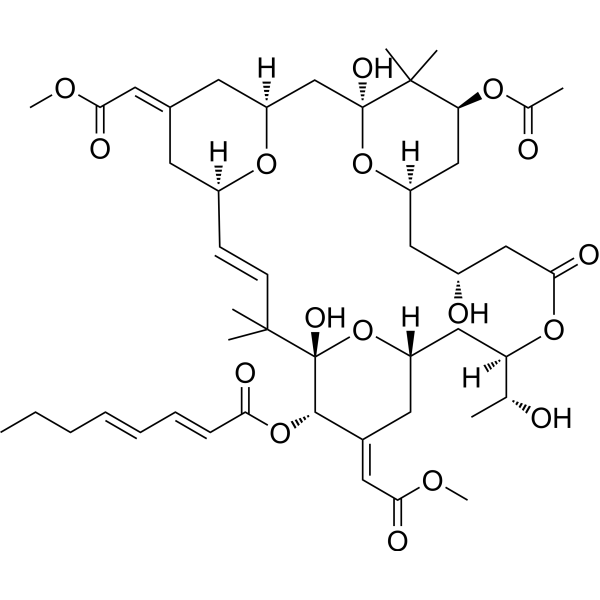MCE Bryostatin 1 ≥99.0%, from bryozoan Bugula neritina , 10 μg
Catalog No :
CAS Number :
Brand :
In Stock
Specifications:
| Application | Protein Biology | ||
| Storage Temperature | -20°C | ||
| Forms | Solid | ||
| Product Brand | MedChem Express | ||
| Product Grade | Analytical grade | Formula | C₄₇H₆₈O₁₇ |
Bryostatin 1 is a naturally occurring marine macrolide isolated from the bryozoan Bugula neritina. It is a potent, central nervous system (CNS)–permeable protein kinase C (PKC) modulator, widely studied for its neuroprotective, anti-cancer, anti-inflammatory, and anti-HIV properties.
Bryostatin 1 directly interacts with the C1 domain of Munc13-1, a key presynaptic regulatory protein, with dissociation constants (Ki) of 8.07 nM for the isolated C1 domain and 0.45 nM for the full-length protein. This high-affinity binding underlies its role in regulating synaptic transmission, neuronal signaling, and immune responses.
Mechanism of Action
Bryostatin 1 functions primarily as a PKC modulator, influencing intracellular signaling pathways through PKC activation and downstream cellular processes.
It also modulates synaptic signaling through Munc13-1 translocation, affecting neurotransmitter release and synaptic plasticity. Due to its CNS permeability, it is actively investigated in neurodegenerative disease models and cognitive research.
In addition, Bryostatin 1 has demonstrated anti-HIV-1 effects and plays a role in immune system modulation, particularly through TLR4 signaling pathways in dendritic cells.
Biological Activity
In Vitro Activity
- In HT22 neuronal cells (1 μM, 5 minutes), Bryostatin 1 induces rapid recruitment of Munc13-1 from the cytosol to the plasma membrane.
- Similar translocation effects are observed with ubMunc13-2 and bMunc13-2 proteins.
- After 24 hours incubation, Bryostatin 1 increases the expression levels of Munc13-1 in both HT22 cells and primary mouse hippocampal neurons.
- It also modulates immune responses by influencing dendritic cell signaling via the TLR4 MyD88-independent pathway, promoting anti-inflammatory, Th2-skewed immune differentiation.
In Vivo Activity
In C57BL/6J mouse models, Bryostatin 1 administered at 30 µg/kg intraperitoneally, 3 days per week for 2 weeks effectively prevented the onset of experimental autoimmune encephalomyelitis (EAE), demonstrating potential therapeutic relevance in neuroinflammatory conditions.
Applications
Bryostatin 1 is widely used in research involving:
- Neurodegenerative diseases (Alzheimer’s disease, cognitive decline)
- Synaptic plasticity and memory research
- Protein kinase C pathway studies
- HIV latency and viral reactivation studies
- Cancer research and signal transduction
- Immunology and T-cell modulation
- Neuroinflammation models
- CNS drug development research
Key Properties
| Parameter | Description |
|---|---|
| Compound Type | Natural marine macrolide |
| Target Pathway | Protein Kinase C (PKC) |
| Secondary Target | Munc13-1 |
| CNS Permeability | Yes |
| Purity | ≥99.0% |
| Biological Actions | Neuroprotective, anti-cancer, anti-inflammatory, anti-HIV |
| Source | Bugula neritina |
| Supplier | MedChemExpress (MCE) |
| Form | Research chemical |
| Application | Research use only |
Bryostatin 1 is a highly potent and CNS-active natural modulator of PKC and Munc13-1, offering significant value in neuroscience, immunology, and oncology research. Its multifaceted biological properties make it an essential compound in studies investigating synaptic function, neuroinflammation, cancer signaling, and viral latency.




 0
0
